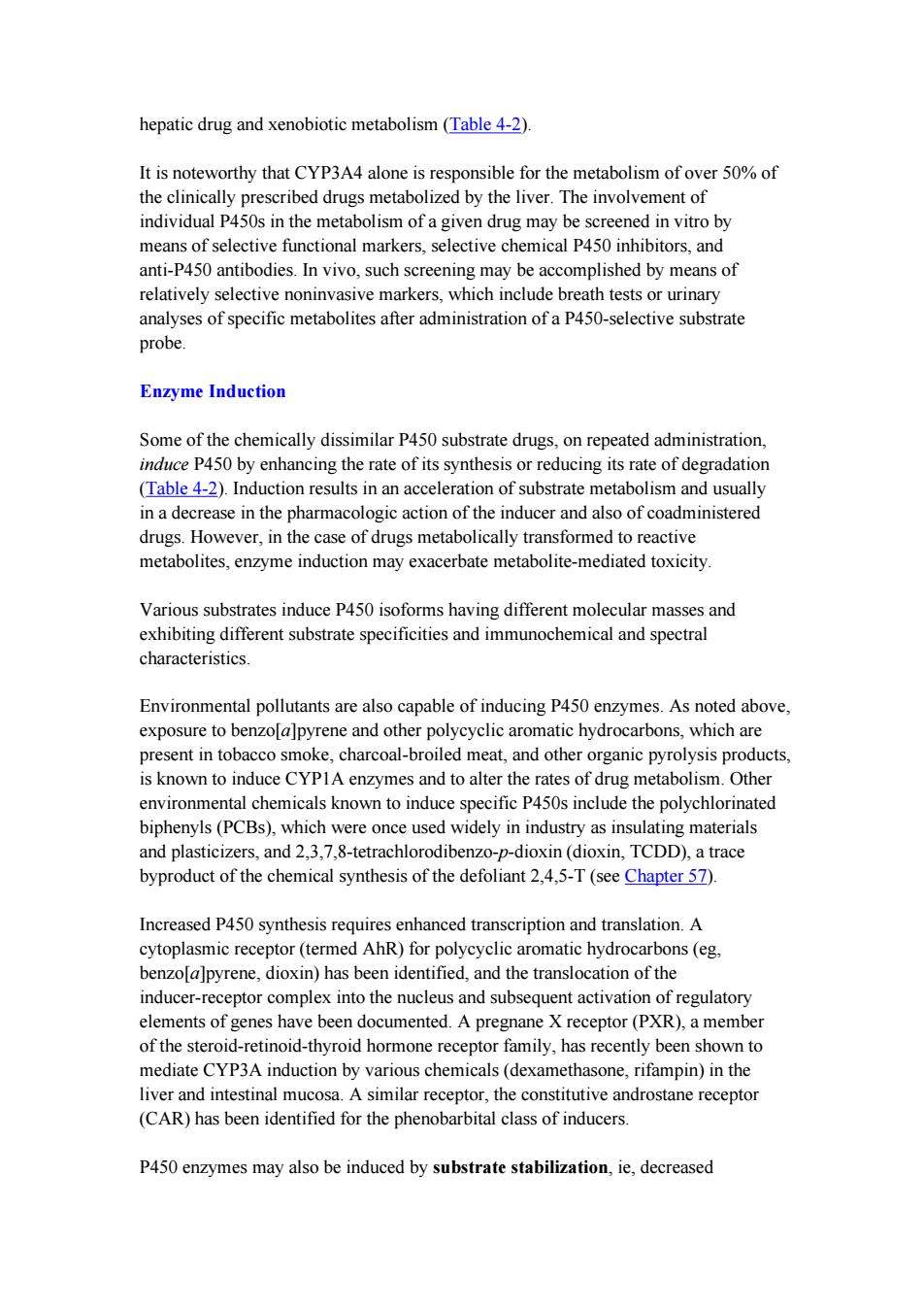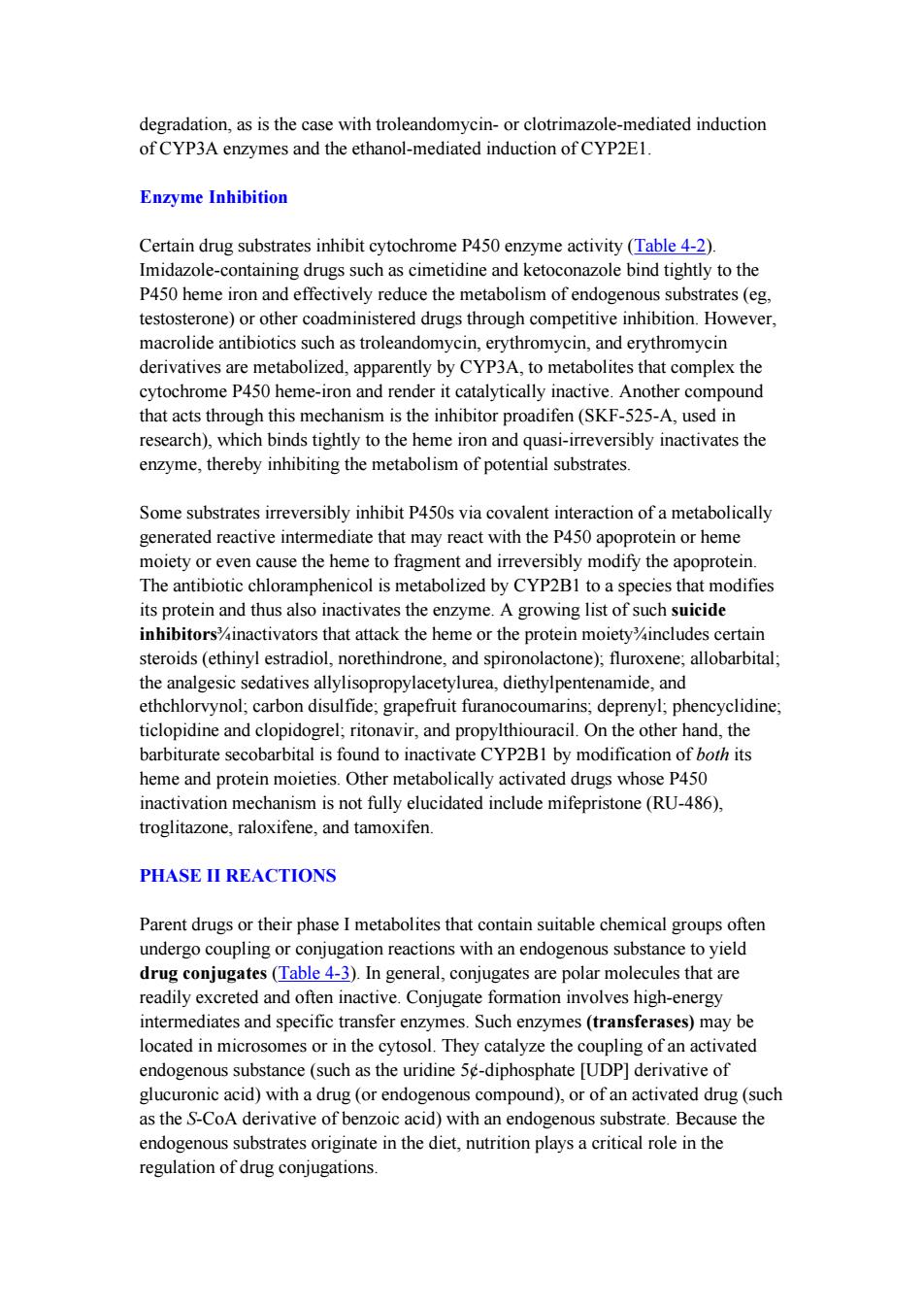
hepatic drug and xenobiotic metabolism(Table 4-2). It is noteworthy that CYP3A4 alone is responsible for the metabolism of over 50%of the clinically prescribed drugs metabolized by the liver.The involvement of individual P450s in the metabolism of a given drug may be screened in vitro by means of selective functional markers,selective chemical P450 inhibitors,and anti-P450 antibodies.In vivo,such screening may be accomplished by means of relatively selective noninvasive markers,which include breath tests or urinary analyses of specific metabolites after administration of a P450-selective substrate probe. Enzyme Induction Some of the chemically dissimilar P450 substrate drugs,on repeated administration, induce P450 by enhancing the rate of its synthesis or reducing its rate of degradation (Table 4-2).Induction results in an acceleration of substrate metabolism and usually in a decrease in the pharmacologic action of the inducer and also of coadministered drugs.However,in the case of drugs metabolically transformed to reactive metabolites,enzyme induction may exacerbate metabolite-mediated toxicity Various substrates induce P450 isoforms having different molecular masses and exhibiting different substrate specificities and immunochemical and spectral characteristics. Environmental pollutants are also capable of inducing P450 enzymes.As noted above, exposure to benzo[a]pyrene and other polycyclic aromatic hydrocarbons,which are present in tobacco smoke,charcoal-broiled meat,and other organic pyrolysis products, is known to induce CYPIA enzymes and to alter the rates of drug metabolism.Other environmental chemicals known to induce specific P450s include the polychlorinated biphenyls(PCBs),which were once used widely in industry as insulating materials and plasticizers,and 2,3,7,8-tetrachlorodibenzo-p-dioxin (dioxin,TCDD),a trace byproduct of the chemical synthesis of the defoliant 2,4,5-T(see Chapter 57). Increased P450 synthesis requires enhanced transcription and translation.A cytoplasmic receptor(termed AhR)for polycyclic aromatic hydrocarbons(eg. benzo[a]pyrene,dioxin)has been identified,and the translocation of the inducer-receptor complex into the nucleus and subsequent activation of regulatory elements of genes have been documented.A pregnane X receptor(PXR),a member of the steroid-retinoid-thyroid hormone receptor family,has recently been shown to mediate CYP3A induction by various chemicals(dexamethasone,rifampin)in the liver and intestinal mucosa.A similar receptor,the constitutive androstane receptor (CAR)has been identified for the phenobarbital class of inducers P450 enzymes may also be induced by substrate stabilization,ie,decreased
hepatic drug and xenobiotic metabolism (Table 4-2). It is noteworthy that CYP3A4 alone is responsible for the metabolism of over 50% of the clinically prescribed drugs metabolized by the liver. The involvement of individual P450s in the metabolism of a given drug may be screened in vitro by means of selective functional markers, selective chemical P450 inhibitors, and anti-P450 antibodies. In vivo, such screening may be accomplished by means of relatively selective noninvasive markers, which include breath tests or urinary analyses of specific metabolites after administration of a P450-selective substrate probe. Enzyme Induction Some of the chemically dissimilar P450 substrate drugs, on repeated administration, induce P450 by enhancing the rate of its synthesis or reducing its rate of degradation (Table 4-2). Induction results in an acceleration of substrate metabolism and usually in a decrease in the pharmacologic action of the inducer and also of coadministered drugs. However, in the case of drugs metabolically transformed to reactive metabolites, enzyme induction may exacerbate metabolite-mediated toxicity. Various substrates induce P450 isoforms having different molecular masses and exhibiting different substrate specificities and immunochemical and spectral characteristics. Environmental pollutants are also capable of inducing P450 enzymes. As noted above, exposure to benzo[a]pyrene and other polycyclic aromatic hydrocarbons, which are present in tobacco smoke, charcoal-broiled meat, and other organic pyrolysis products, is known to induce CYP1A enzymes and to alter the rates of drug metabolism. Other environmental chemicals known to induce specific P450s include the polychlorinated biphenyls (PCBs), which were once used widely in industry as insulating materials and plasticizers, and 2,3,7,8-tetrachlorodibenzo-p-dioxin (dioxin, TCDD), a trace byproduct of the chemical synthesis of the defoliant 2,4,5-T (see Chapter 57). Increased P450 synthesis requires enhanced transcription and translation. A cytoplasmic receptor (termed AhR) for polycyclic aromatic hydrocarbons (eg, benzo[a]pyrene, dioxin) has been identified, and the translocation of the inducer-receptor complex into the nucleus and subsequent activation of regulatory elements of genes have been documented. A pregnane X receptor (PXR), a member of the steroid-retinoid-thyroid hormone receptor family, has recently been shown to mediate CYP3A induction by various chemicals (dexamethasone, rifampin) in the liver and intestinal mucosa. A similar receptor, the constitutive androstane receptor (CAR) has been identified for the phenobarbital class of inducers. P450 enzymes may also be induced by substrate stabilization, ie, decreased

degradation,as is the case with troleandomycin-or clotrimazole-mediated induction of CYP3A enzymes and the ethanol-mediated induction of CYP2E1 Enzyme Inhibition Certain drug substrates inhibit cytochrome P450 enzyme activity (Table 4-2) Imidazole-containing drugs such as cimetidine and ketoconazole bind tightly to the P450 heme iron and effectively reduce the metabolism of endogenous substrates(eg testosterone)or other coadministered drugs through competitive inhibition.However, macrolide antibiotics such as troleandomycin,erythromycin,and erythromycin derivatives are metabolized,apparently by CYP3A,to metabolites that complex the cytochrome P450 heme-iron and render it catalytically inactive.Another compound that acts through this mechanism is the inhibitor proadifen(SKF-525-A,used in research),which binds tightly to the heme iron and quasi-irreversibly inactivates the enzyme,thereby inhibiting the metabolism of potential substrates Some substrates irreversibly inhibit P450s via covalent interaction of a metabolically generated reactive intermediate that may react with the P450 apoprotein or heme moiety or even cause the heme to fragment and irreversibly modify the apoprotein. The antibiotic chloramphenicol is metabolized by CYP2B1 to a species that modifies its protein and thus also inactivates the enzyme.A growing list of such suicide inhibitors%inactivators that attack the heme or the protein moietyincludes certain steroids(ethinyl estradiol,norethindrone,and spironolactone);fluroxene;allobarbital; the analgesic sedatives allylisopropylacetylurea,diethylpentenamide,and ethchlorvynol;carbon disulfide;grapefruit furanocoumarins;deprenyl;phencyclidine; ticlopidine and clopidogrel;ritonavir,and propylthiouracil.On the other hand,the barbiturate secobarbital is found to inactivate CYP2BI by modification of both its heme and protein moieties.Other metabolically activated drugs whose P450 inactivation mechanism is not fully elucidated include mifepristone(RU-486), troglitazone,raloxifene,and tamoxifen. PHASE II REACTIONS Parent drugs or their phase I metabolites that contain suitable chemical groups often undergo coupling or conjugation reactions with an endogenous substance to yield drug conjugates(Table 4-3).In general,conjugates are polar molecules that are readily excreted and often inactive.Conjugate formation involves high-energy intermediates and specific transfer enzymes.Such enzymes (transferases)may be located in microsomes or in the cytosol.They catalyze the coupling of an activated endogenous substance(such as the uridine 5c-diphosphate [UDP]derivative of glucuronic acid)with a drug (or endogenous compound),or of an activated drug(such as the S-CoA derivative of benzoic acid)with an endogenous substrate.Because the endogenous substrates originate in the diet,nutrition plays a critical role in the regulation of drug conjugations
degradation, as is the case with troleandomycin- or clotrimazole-mediated induction of CYP3A enzymes and the ethanol-mediated induction of CYP2E1. Enzyme Inhibition Certain drug substrates inhibit cytochrome P450 enzyme activity (Table 4-2). Imidazole-containing drugs such as cimetidine and ketoconazole bind tightly to the P450 heme iron and effectively reduce the metabolism of endogenous substrates (eg, testosterone) or other coadministered drugs through competitive inhibition. However, macrolide antibiotics such as troleandomycin, erythromycin, and erythromycin derivatives are metabolized, apparently by CYP3A, to metabolites that complex the cytochrome P450 heme-iron and render it catalytically inactive. Another compound that acts through this mechanism is the inhibitor proadifen (SKF-525-A, used in research), which binds tightly to the heme iron and quasi-irreversibly inactivates the enzyme, thereby inhibiting the metabolism of potential substrates. Some substrates irreversibly inhibit P450s via covalent interaction of a metabolically generated reactive intermediate that may react with the P450 apoprotein or heme moiety or even cause the heme to fragment and irreversibly modify the apoprotein. The antibiotic chloramphenicol is metabolized by CYP2B1 to a species that modifies its protein and thus also inactivates the enzyme. A growing list of such suicide inhibitors¾inactivators that attack the heme or the protein moiety¾includes certain steroids (ethinyl estradiol, norethindrone, and spironolactone); fluroxene; allobarbital; the analgesic sedatives allylisopropylacetylurea, diethylpentenamide, and ethchlorvynol; carbon disulfide; grapefruit furanocoumarins; deprenyl; phencyclidine; ticlopidine and clopidogrel; ritonavir, and propylthiouracil. On the other hand, the barbiturate secobarbital is found to inactivate CYP2B1 by modification of both its heme and protein moieties. Other metabolically activated drugs whose P450 inactivation mechanism is not fully elucidated include mifepristone (RU-486), troglitazone, raloxifene, and tamoxifen. PHASE II REACTIONS Parent drugs or their phase I metabolites that contain suitable chemical groups often undergo coupling or conjugation reactions with an endogenous substance to yield drug conjugates (Table 4-3). In general, conjugates are polar molecules that are readily excreted and often inactive. Conjugate formation involves high-energy intermediates and specific transfer enzymes. Such enzymes (transferases) may be located in microsomes or in the cytosol. They catalyze the coupling of an activated endogenous substance (such as the uridine 5¢-diphosphate [UDP] derivative of glucuronic acid) with a drug (or endogenous compound), or of an activated drug (such as the S-CoA derivative of benzoic acid) with an endogenous substrate. Because the endogenous substrates originate in the diet, nutrition plays a critical role in the regulation of drug conjugations